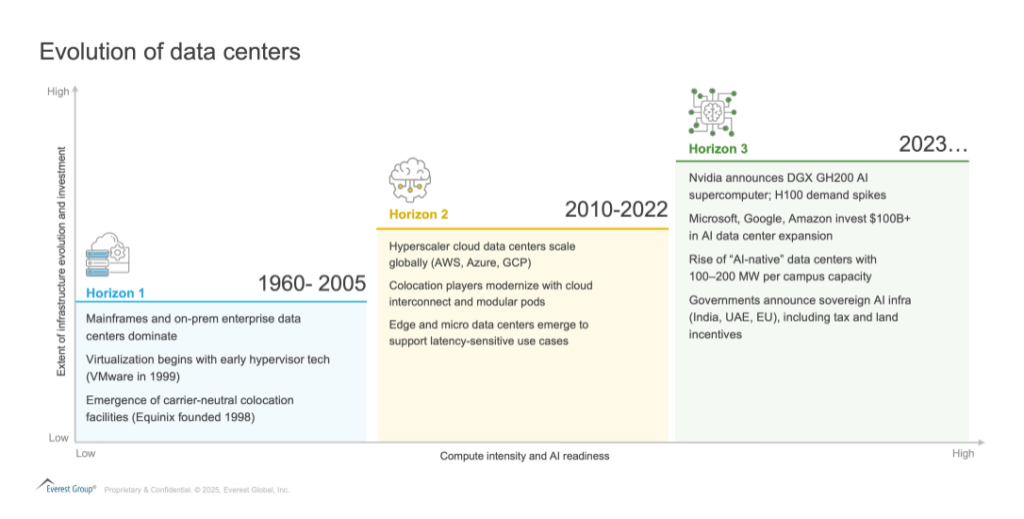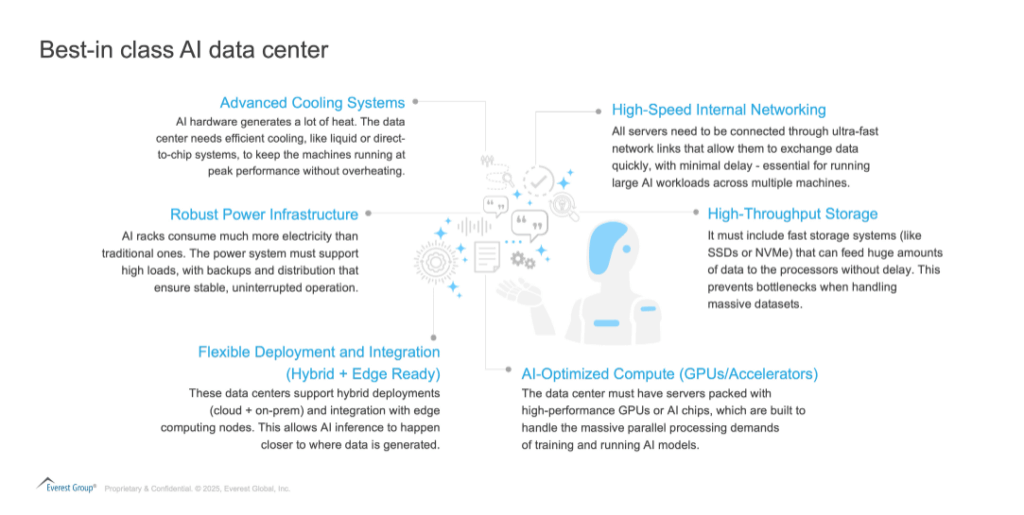Strategic Imperatives for Capturing the AI-Era Data Center Opportunity


Data centers have long served as the quiet backbone of the digital economy. But the rise of generative AI (gen AI) has triggered a foundational shift in how they are designed, built, and scaled.
Their evolution spans three horizons: from early mainframes to the hyperscale cloud boom, and now into an artificial intelligence (AI)-native future. Each horizon has brought a step-change in architecture and strategic relevance, but today’s transformation is unlike any before.
In this latest phase, data centers are no longer optimized merely for general-purpose compute. They’re being rearchitected to support AI workloads that demand massive power density, dynamic scalability, and purpose-built infrastructure. This transformation is not just a technological evolution; it represents a fundamental realignment of the digital infrastructure that underpins global innovation.
Reach out to discuss this topic in depth.
Exhibit 1: Evolution of data centers

The coming wave of data center growth will be defined not just by scale, but by strategic fit such as support for next-gen compute, regional sovereignty, and AI-readiness. Enterprises are no longer passive consumers of capacity – they are actively shaping data center priorities around regulatory needs, workload demands, and sustainability goals.
As the global demand for compute infrastructure accelerates, enterprises, service providers, and tech vendors must align their strategies to capitalize on the data center Supercycle. Whether operating in mature markets like the US and Europe or in rapidly growing hubs like India, success will depend on speed, adaptability, and ecosystem collaboration.
Forces shaping AI-data-center design – what “best-in-class” looks like
AI workloads have fundamentally different infrastructure requirements compared to traditional cloud-native or enterprise workloads. While legacy data centers were primarily built for general-purpose compute and storage, AI-centric environments require significantly greater compute density, data throughput, and thermal efficiency.
Building a truly “AI-first” data center isn’t just about stacking Graphics Processing Units (GPUs), it’s about reengineering the physical and digital fabric to meet unprecedented demands of performance, density, and efficiency.
It requires a complete re-architecture of the data center, covering compute, networking, storage, power, cooling, and deployment. The following exhibit outlines six essential capabilities that enable AI performance at scale.

With demand for AI infrastructure surging, the challenge is no longer just about technical capability. It is about whether the supply side can respond with speed, scale, and precision. To capture this opportunity, operators, cloud providers, colocation firms, and ecosystem enablers must rethink how capacity is financed, built, interconnected, and sustained.
This calls for a fundamentally new supply-side playbook – one designed to deliver AI infrastructure at scale, with agility, resilience, and long-term strategic alignment.
The supply-side playbook: evolving for AI-datacenters at scale
As the AI wave reshapes the infrastructure landscape, different ecosystem players such as service providers, Original Equipment Manufacturer (OEMs), chipmakers, and infrastructure partners must adapt their strategies to deliver differentiated, AI-ready platforms. Here’s how:
-
- Service providers (hyperscalers, colocation, and managed services)
Service providers have a substantial opportunity to grow by expanding data center capabilities tailored specifically for AI workloads.
-
- Infrastructure scaling: Rapidly expand data center capacity specifically designed for AI computing needs
-
- Custom AI infrastructure: Integrate specialized data center hardware optimized for AI performance and efficiency
-
- AI-as-a-Service/ GPU-as-a-Service: Offer flexible, cloud-delivered GPU compute environments optimized for AI development, deployment, and scaling
-
- Original Equipment Manufacturers (OEMs like Dell, HPE)
OEMs can capture significant value by providing AI-centric hardware and solutions tailored explicitly for advanced data center environments.
-
- AI-optimized hardware: Deliver servers, network switches, cooling, and storage systems specifically engineered for the high density and high-performance demands of AI data centers
-
- Integrated data center solutions: Offer comprehensive, turnkey AI infrastructure packages combining hardware, software, and support optimized for data center deployments
-
- Strategic data center alliances: Partner with chip manufacturers and cloud providers to create integrated, data-center-specific AI solutions
-
- Silicon vendors (NVIDIA, AMD, Intel, AI Startups)
Silicon vendors have significant growth opportunities by developing and supplying accelerators tailored for high-density, high-performance AI data center environments.
-
- Accelerator innovation: Continuously enhance GPU and AI-specific accelerator performance and energy efficiency for data center applications
-
- End-to-end data center platforms / factories: Provide comprehensive, integrated platforms simplifying AI deployment and management within data centers
-
- Infrastructure providers (Power, cooling, real estate, builders)
Infrastructure specialists are positioned to benefit by delivering solutions uniquely suited to the intense power and cooling demands of AI data centers.
-
- Advanced cooling solutions: Provide innovative liquid and immersion cooling technologies essential for managing extreme heat densities in AI data centers
-
- Power reliability: Offer robust and resilient power infrastructure, including high-capacity on-site power generation solutions suitable for AI-intensive data centers
-
- Sustainable construction: Employ modular, prefabricated construction techniques and renewable energy solutions specifically designed to meet sustainability objectives for AI data centers
By strategically pursuing these data-center-specific opportunities, stakeholders across the ecosystem can effectively capitalize on the rapid growth and evolution driven by AI technologies.
Capturing the AI-era data center opportunity requires more than incremental upgrades; it demands a strategic reset. The future will be defined by those who move with speed, precision, and purpose to build AI-native, resilient digital infrastructure.
You can read more via: https://www.everestgrp.com/reportaction/EGR-2025-29-V-6983/Toc?SearchTerms=AI%20infrastructure
If you enjoyed this blog, check out our Cloud & Infrastructure Services – Everest Group, which delves deeper into other topics regarding CIS practices.
To learn more about AI and AI data center offerings, as well as anything else relating to artificial intelligence, please contact Tanvi Rai ([email protected]) and Mukesh Ranjan ([email protected]).